Sugarcane crop is affected by more than 60 insects of which about 10 insects are rather more important as far as the yield loss is concerned. Among the major insects damaging sugarcane, borers, sucking pests, soil dwelling insects are more prevalent in Tamil Nadu and adjoining states which account 20% loss in cane yield 15% loss in sugar yield. |
Sl.No |
Common Name |
Scientific Name |
Family |
Order |
1 |
Early shoot borer |
Chilo infuscatellus |
Crambidae |
Lepidoptera |
2 |
Internode borer |
Chilo sacchariphagus indicus |
Crambidae |
Lepidoptera |
3 |
Top borer |
Scirphophaga excerptalis |
Pyralidae |
Lepidoptera |
4 |
Termites |
Odontotermes obesus |
Termitidae |
Isoptera |
5 |
White grubs |
Holotrichia Consanguinea |
Melolonthidae |
COleoptera |
6 |
Woolly aphid |
Ceratovacuna lanigera |
Phempigidae |
Hemiptera |
7 |
White fly |
Aleurolobus barodensis
Neomaskellia bergii
N . andropogonis |
Aleyrodidae |
Hemiptera |
8 |
Mealy bug |
Saccharicoccus sacchari |
Pseudococcidae |
Hemiptera |
9 |
Scale insects |
Melanaspis glomerata |
Diaspididae |
Hemiptera |
10 |
Nematode |
Reniform nematode - Rotylenchulus reniformis.
Root knot nematode –Meloidogyne spp
Lance nematode – Hoplolaimus indicus
Lesion nematode - Pratylenchus coffeae |
Trichostrongylidae |
Monhysterida |
11 |
Grasshopper |
|
|
|
Early shoot borer, Chilo infuscatellus snellen
Discription:
Tamil Nadu, Andra Pradesh, U.P., Bihar, West Bengal, Maharastra, Madhya Pradesh, Punjab, Rajasthan. In Tamil Nadu, its occurance is noted in all sugarcane growing areas. |
Symptom of damage:
Dead heart in 1-3 month old crop, which can be easily pulled out, rotten portion of the straw coloured dead – heart emites an offensive odour. A number of bore holes at the base of the shoot just above the ground level. |
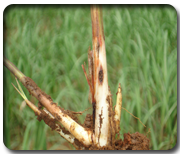 |
Life cycle:
-
Egg: Flat – scale like eggs are laid in 3-5 rows on the lower surface of leaves in masses of 4-100. The masses are slightly overlapping like tiles. It hatches 4-6days.
-
Larva: Larva is dirty white with five dark violet longitudinal stripes and dark brown head. Duration 16-30days.
-
Pupa: Pupation takes within the tunnel. Caterpillar before pupating makes a large exit hole in the stem and blocks the opening with silken discs.
-
Adult: Pale greyish brown moth with black dots near the coastal margin of the forewings and with white hind wings.
|
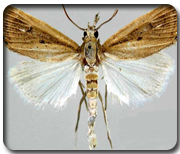 |
Management:
Cultural method:
-
Use resistant varities like CO 312, CO 421, CO 661, CO 917 and CO 853
-
Early planting during December – January escapes the shoot borer incidence.
-
Daincha intercropped sugarcane record the lowest early shoot borer incidence.
-
Trash mulching along the ridges to a thickness of 10-15 cm 3 days after planting.
-
Ensure adequate moisture to bring down the soil temperature and increase humidity (unfavourable condition for the multiplication of early shoots borer).
|
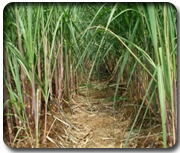 |
Physical method:
|
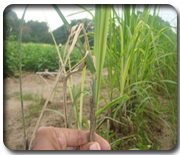 |
Biological method:
|
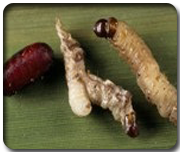 |
Chemical method
-
Apply any one of the following insecticides if the pest crosses ETL.
-
Carboryl +Lindane (Sevidol) 4% G 12.5 kg, lindane 10 G 12.5 kg, Carbofuron 3G 33 kg (Soil application). The granular application should be immediately followed by irrigation.
-
Chlorpyriphos 1000 ml a sticker like Teepol (250 ml / 500 l of water) can also be added to make the solution stick on to the surface of the crop and it is preferable to use high volume sprayer to be most effective.
|
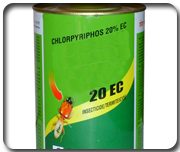 |
Internode Borer, Chilo sacchariphagus indicus (Kapur)
Distribution:
Major pest in tropical India
Symptom of damage:
Internodes constricted and shortened, with a number of boreholes and fresh excreta in the nodal region. Affected tissues reddened.
Nature of damage:
Caterpillars attack sugarcane plants after 3 months of planting. They bore into the canes near the nodes; entry holes are plugged with excreta. Entry is generally confined to the first five internodes. |
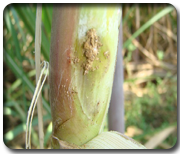 |
Life cycle:
-
Egg: Scale – like oval, flat, shiny and waxy white eggs are laid by female moths in batches of 9-11, near the midribs, on leaf sheaths or on stem.
-
Larva: White larva with four violet longitudinal stripes and light brown head.
-
Pupa: Pupation takes place in semi – dried sheath. Pupal period 7 - 10 days
-
Adult: straw coloured with a dark spot on each of the forewings
|
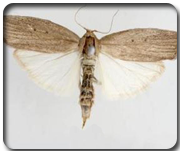 |
Management:
Cultural method:
-
Use resistant varities like CO 975,COJ 46 and CO 7304
-
Select internode borer damage free setts for planting
-
Detrashing & burying the trash during the 5th, 7th and 9th month
|
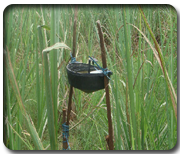 |
Physical method:
|
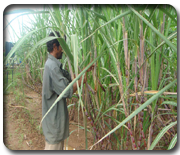 |
Biological method:
-
Release egg parasite, Trichogramma chilonis at the rate of 2.5 cc / release / ha. Six release at fortnightly intervals starting from 4th month onwards.
-
Setting pheromone traps at spindle level on 5th month of the crop at the rate of 6 traps per acre in a 15 metre grid. The pheromone septa need to be changed twice at 75 days interval.
|
|
Chemical method:
|
|
Top Borer, Scirpophaa excerptalis (Fb.)
Distribution:
Present in all states. In Tamil Nadu it is severe in Trichy, Tanjore and Cuddalore districts.
Symptom of damage:
-
Dead heart arise on after sixth month grown up canes, which cannot be easily pulled.
-
Parallel row of shot holes in the emerging leaves.
-
Bore holes at the top of the shoot and shows bunchy top appearance.
|
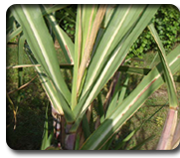 |
Nature of damage:
Caterpillars are mainly found in the apical portion of the canes, boring through the growing point and down the upper joints until it reaches the sappy portion of the stem, there it feeds on the tissues and destroys the cane. They also bore into the unfolded leaves preferably into the midrib, mining its way to the base. |
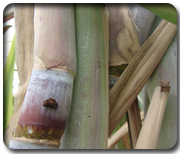 |
Life cycle:
-
Egg: Eggs are laid on the lower surface of top leaves in clusters particularly near midribs. The clusters are covered with buff coloured hairs. : 10-80 eggs per egg mass
-
Larva: Smooth, white or cream coloured with a red coloured mid – dorsal line and yellow head.
-
Pupa: Pupation takes place within the larval tunnel in a chamber with an exit hole Constructed by the caterpillar. Pupal period 6 - 21 days
-
Adult: White Coloured moth (with a buff Coloured anal tuft in the abdominal tip of female)
|
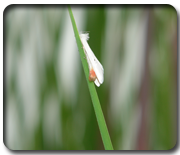 |
Management:
Cultural method:
Physical method:
|
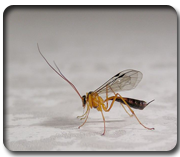 |
Biological method:
Chemical method:
|
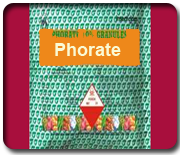 |
Termites, Odontotermes obesus Rhamb
Symptom of damage:
Poor germination of setts (after planting), characteristic semi – circular feeding marks on the margin of the leaves in the standing crop. Causes yellowing and drying of outer leaves first followed by the inner leaves Entire shoot dries up and can be pulled out. Setts hollow inside and may be filled with soil. Cane collapses if disturbed; rind filled with mud.
|
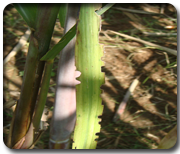 |
Life cycle:
Eggs: Dull, kidney shaped and hatches in 30-90 days
Nymphs: Moult 8-9 times and are full grown in 6-12 months
Adult: Creamy coloured tiny insects resembling ants with dark coloured head
|
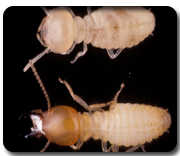 |
Management:
Cultural method:
Physical method:
|
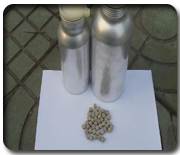 |
Chemical method:
-
Fumigate the termite mounds with aluminium phosphate 2 tablets / 1 meter/Mounds.
-
Dip the setts in imidacloprid 70WS 0.1% or chlopyriphos 20 EC 0.04% for 5min.
-
Treat the soil with lindane 1.6 D @ 50 kg / ha or
-
Apply 125 kg of heptachlor 3 % D per ha in the furrows at time of planting.
|
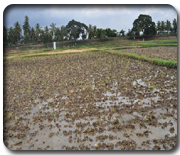 |
White Grub, Holotrichia consanguinea (Blanch)
Symptom of damage:
-
Yellowing and wilting of leaves.
-
Drying of entire crown.
-
Affected canes come off easily when pulled.
-
Cause extensive damage to roots and base of shoot.
|
Life cycle:
Egg: A female lays on an average of 27 eggs in the soil, which are pear like white enclosed in earthen cells.
Grub: Fleshy ‘C’ shaped, whitish yellow in colour found close to the base of the clump.
Pupa: Pupae are tan to brown, and occur deeper in the soil in earthen chambers.
Adult: Adult beetles are a rusty-red color just after emerging from the pupal stage, but turn nearly black. |
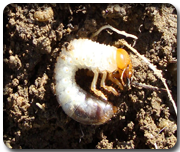 |
Management:
Cultural method:
Physical method:
|
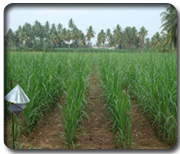 |
Chemical method:
|
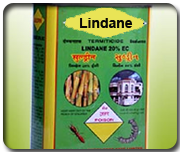 |
Sugarcane Wooly Aphid, Ceratovacuna lanigera
Symptoms:
Adults and nymphs desap leaves by piercing styles through stomata. Whitish patches – coalesce to turn yellowish and drying from the tip along margins. Leaves become brittle and dries completely. Heavy secretion of honey dew – development of sooty mould. Deposition of wooly matter on ground / soil distinctly visible. |
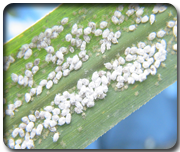 |
Life cycle:
Adult emerged after fourth moult and viviparous reproduction. Apterous (Wingless) female reproduce parthenogenetically. Each femal produced about 15 – 35 young ones within 24 hr after mating. Each female reproduces maximum of 217 nymphs during the period of 20 days. The female are more in the population, which leads to fast multiplication. Nymph takes 6 to 22 days to complete four instars and become adult.
The life cycle of female complete within one – month period. The longevity of adult is from 32 to 57 days. The life cycle may vary according to the climatic conditions and variety. In most of the affected fields at various locations all the nymphal instars and adults are noticed. In extreme cases, the winter is passed as eggs which are laid during the previous autumn by sexual females. In spring they hatch and give rise to apterous parthenogenetic viviparous females. The winged females appear in such swarms as to darken the sky and cover the vegetation. The non-migratory species, the whole life – cycle is spent on the same plant. |
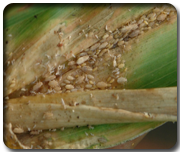 |
Management:
Cultural Method:
-
Paired row system of planting.
-
Avoid excessive use of nitrogenous fertilizers.
-
Use of organic fertilizers.
-
Rapping of canes all along the rows.
-
Infested tops should not be transported.
-
Infested canes should not be used as seed for planting.
Biological Method:
-
Encourage local predators like Diapha aphidivora Meyrick – Pyralidae
-
Ishchiodon scutellaris
-
Episyrphus baleatus – Syrphidae
-
Chrysopa spp. – Chryospidae
-
Schymnus sp.
-
Cheilomeness sexmaculata, Coccinella septempunctata, Synnonycha grandis
-
Brumus sp. and
-
Dideopsis aegrota – Coccinellidae
-
Pathogens like Cladosporium oxysporum, Metarhizium anisopliae, Verticillium lecanii and Beauveria bassiana
|
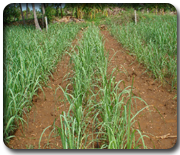 |
Chemical Method:
Dip the seed sets in Chlorpyripos 20 EC solution (2 ml / lit) before planting. Apply phorate 10 G @ 5kg / ac or Spray with acephate75 SP 1g / lit Chlorpyriphos 20 EC 2 ml / lit Malathion 50 EC 2 ml / lit Dimethoate 30 EC 1.7 ml / lit, Oxydemeton methyl 25 EC 1.3 ml / lit, Dusting with Malathion 5% dust @ 10 kg / ac. |
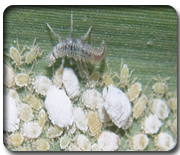 |
Whiteflies, Aleurolobus barodensis
Symptom of damage:
|
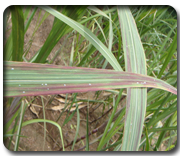 |
Life cycle:
-
Egg: Females lay eggs in a line near the midrib or any where on the lower surface of the leaves. Eggs are yellowish with a small curved stalk. Colour changes to black about two hours after the eggs are laid.
-
Nymph & Pupa: Neonate nymphs are pale yellow in colour, flat and oval in shape, later turn shiny black. Its body is surrounded by fringes of wax.The fourth instar being the pupal stage, is flat, oval, grayish in colour and slightly bigger than the nymph. There is a ‘T’ shaped white marking on the thorax, which splits at the time of adult emergence.
-
Adult: Pale yellow body with hyaline wings dusted with waxy bloom, exhibit brisk fluttering movements.
|
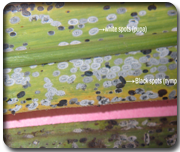 |
Management:
Cultural Method:
Avoid indiscriminate use of insecticides for control of other pests such as pyrilla, black bug, wooly aphids
Mechanical Method:
Detrashing the puparia bearing leaves and immediately disposing by burning or burying to prevent emergence of adult white flies
Chemical Method:
Spray fenitrothion 50 EC @ 2 lit / ha (1000 lit spray fluid) |
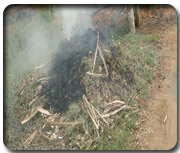 |
Mealybug, Saccharicoccus sacchari
Symptom of damage:
Pinkish oval insects beneath leaf sheath on the nodes, with whitish mealy coating, main cane stunned also attack roots. Sooty mould develops on the honey dew giving blackish appearance on canes. |
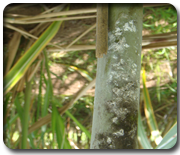 |
Life cycle:
Eggs: Eggs are retained in the female reproductive organs untils almost fully mature. Incubation period is short. The females may bring forth hundreds of young ones parthenogenetically. Egg is yellowish, smooth, cylindrical and rounded at both ends.
Nymph: Newly emerged nymphs are quite active with a pinkish transparent body.
Adult: White with mealy coating, sessile. |
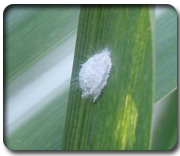 |
Management:
Cultural method:
-
Use resistant varieties like CO 439, CO 443, CO 720, CO 730 and CO 7704
-
Drain excess water from the field.
Physical method:
|
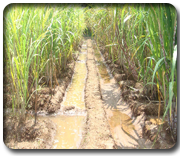 |
Chemical method:
|
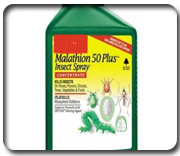 |
Scale Insects, Melanaspis glomerata (Green)
Symptom of damage:
-
The leaves of infested canes show signs of tip drying and unhealthy pale green colour and with continued infestation these turn yellow.
-
Desapping leads to non-opening of leaves also, which also turn yellow and finally dry up.
-
Nodal region is more infested than internodal region.
-
Infested crop losses its vigour, canes shrivel, growth is stunted and the internodal length is reduced drastically.
-
Ultimately cane dries up. Such canes when slit open appear brownish red.
|
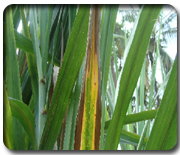 |
Life cycle:
Nymph: Females multiply ovo-viviparously. The nymphs that hatch out from the eggs within the female’s body come out through the genital aperture. They are called ‘crawlers’. They settle after selecting suitable site for feeding.
Adult: Greyish black or brown circular scales, they cover the nodal region forming a thick encrustation. |
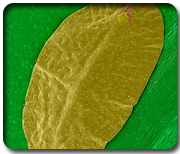 |
Management:
Cultural method:
-
Use resistant varieties like CO 439, CO 443, CO 453, CO 671, CO 691 and CO 692
-
Select and plant the scale insect free setts.
-
Keep the fields and bunds free from weeds.
-
Avoid water stagnation in the field for the longer period.
-
Avoid repeated ratoons.
Physical method:
|
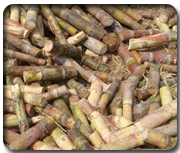 |
Biological method:
Chemical method:
|
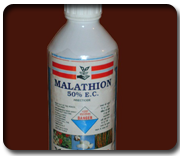 |
Nematodes
Symptom:
-
Usually paling of leaves, first in the form of streaks, later complete yellowing-chlorosis, occurring in patches spread out all over the field. Chlorosis in severe cases, accompanied by drying up of margins and leaf tips is more common in ratoon and young crop.
-
Stunting of crop, reduction in number and size of internodes.
-
Roots are stubby and spares.
-
Affected field shows pale green to whitish look.
|
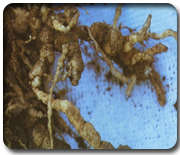 |
Nematode types:
There are several nematodes present in the soil of which, four nematodes are mainly damaging the sugarcane crop. They are:
Lesion nematode - Pratylenchus coffeae
Root-lesion nematodes are migratory endoparasites Females of P. penetrans lay about 1 or 2 eggs/day for about 35 days, with a maximum of 68 eggs being laid by one female. Eggs are laid singly or in clusters in both soil and roots. Second stage juveniles hatch after eggs have incubated for 9 (30 C) to 25 (15 C) days. Males are required for reproduction by P. penetrans but not by P. neglectus. |
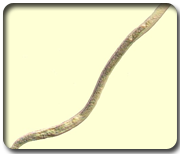 |
Lance nematode - Hoplolaimus indicus
Lance nematodes, Hoplolaimus spp., are ecto-parasites, sometimes semi-endo-parasites. Nematodes which are large and highly resistant to effects of temperature extremes and dry soil conditions. Larvae look similar to adults except that they are smaller.This group of nematodes is easily detected with soil sampling. |
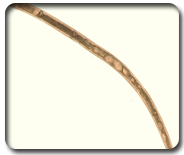 |
Root knot nematode - Meloidogyne spp.
Root knot nematodes are microscopic roundworms, obligate endo-parasites that complete most of their life cycle within their host roots. The nematodes survive in soil as eggs and also second stage larvae. |
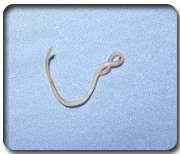 |
Reniform nematode - Rotylenchulus reniformis.
The term 'reniform' refers to the kidney-shaped body of the mature female. They are semi-endoparasitic (partially inside roots) species in which the females penetrate the root cortex, establish a permanent-feeding site in the stele region of the root and become sedentary or immobile. |
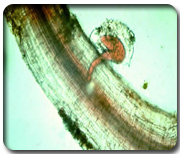 |
Management:
Cultural method:
-
Deep ploughing, solarisation, flooding, crop rotation and apply organic manure.
-
Under wetland conditions, intercropping with sunnhemp or marigold or daincha
-
Apply pressmud at 15 t/ha or poultry manure @ 2 t/ha or neem cake 2 t/ha or poultry manure @ 1 t/ha before last ploughing in garden lands.
Biological method:
|
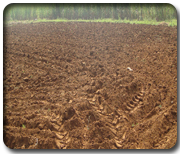 |
Chemical method:
|
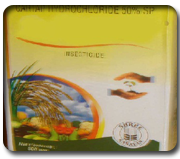 |
Grasshoppers, Hieroglyphus banyan
Symptom of damage:
|
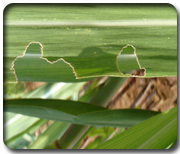 |
Identification of pest:
Egg: Eggs in the form of egg pods, usually more than ten, either in the sand or among leaf litters. Each egg pod consists of about 10-300 eggs that are rice shaped.
Nymph:
Nymphs are miniature versions of adult grasshoppers, except that they are light in colour and do not possess wings. The nymphal stage may last for a period of 5-10 days.
Adult:
After about a month, a nymph becomes an adult. An adult grasshopper lives for 1-2 months. |
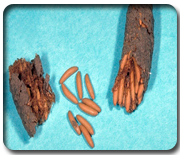 |
Management:
Cultural method:
Tillage - Tillage controls grasshoppers primarily by eliminating the green plants on which grasshoppers feed.
Biological method:
Baits containing the protozoan Nosema locustae is a biological control option that may be considered for treating grasshopper breeding sites. This is sold under the trade names Nolobait or Semaspore and can produce infection of many species of grasshoppers. Because it is selective in effects, only affecting grasshoppers. |
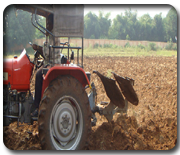 |
Sugarcane Diseases
Red rot
Symptoms
The affected canes exhibit leaf colour change, from green to orange and then to yellow in the third or fourth leaf. Then the leaves start drying from bottom to top. The cane loses its normal colour and longitudinal discoloration spots / ribs are seen. The internode region shrinks with rupture of tissue in the root eye region and the spores are ejected from these spots. If the fungal spores enter the leaf sheath through the leaf midrib, then reddish spots can be seen on the backside of the leaf midrib also. The external symptoms appear only after16 - 21 days after infection and drying of entire cane takes another 10 days time. When the affected cane is split opened, the inner region is reddish in colour with intermittent white tinges across the cane length. If the variety is highly susceptible or disease incidence is severe, ash colour fungal growth is seen inside the cane. Sometimes, the pith inside the cane is filled with blackish brown liquid and exhibited alchohol odour.
|
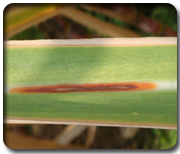 |
Identification of pathogen
-
Red rot disease is caused by the fungus Glomerella tucumanensis. An older name, Colletotrichum falcatum, is still preferred by some pathologists.
-
Pathogen present on leaf sheaths and blades, solitary or aggregated, often forming short lines between vascular bundles, globose, immersed, dark brown to black 65-250 µm diam.; wall up to 8 cells thick, sclerotia on outside, pseudoparenchymatous within, ostiole slightly papillate, circular.
|
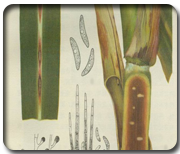 |
Management
Cultural method:
-
The red rot affected field must be rotated with rice for one season and other crops for two seasons.
-
Growing of recommended resistant and moderately resistant varieties viz., Co 86249, CoSi 95071, CoG 93076, CoC 22, CoSi 6 and CoG 5
Physical method:
|
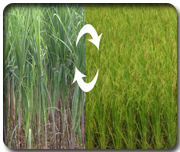 |
Chemical method:
|
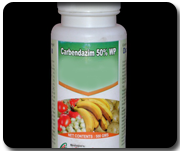 |
Sett Rot
-
When diseased setts are planted they may rot before germination, or the shoots may die after reaching a height of about 6-12 inches.
-
As the setts get dried up, the reddish colour becomes black with lots of black coloured fungal spores adhering to it.
-
If infected shoots survive, they are very much stunted and chlorotic.
-
Eventually the leaves may wither and the shoots wilt.
-
If the affected shoots and setts are examined the central portion of the shoots will be seen discoloured red and the contents of the sett rotting.
-
When split opened, the affected setts exhibit pineapple odour.
|
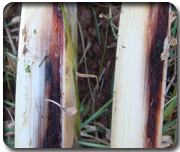 |
Identification of pathogen:
Ceratocytis paradoxa were initially whitish, measuring about 5 mm in diameter. The colonies were turned black due to the production of chlamydospores, which are heavily pigmented, when mature. |
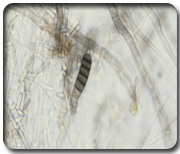 |
Management
Cultural method:
Chemical method:
-
Sett treatment with Carbendazim or bavistin before planting (Bavistin @ 1per cent or Carbendazim 50 WP @0.5 gm in 1 litre of water or Carbendazim 25 DS @ 1gm in 1 litre of water along with Urea @10 gm in 1 litre of water for 5 minutes)
-
Pre treatment the setts with hot water has been found to stimulate germination of buds and hasten growth soa s to help the young plants to overcome the competition with the pathogen.
|
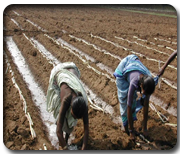 |
Smut
Symptoms
-
Production of whip like structure of 25 – 150 cm. from the growing point of the canes.
-
Whip covered by translucent silvery membrane enclosing mass of black powdery spores.
-
Initial thin canes with elongated internodes later become reduced in length.
-
Profuse sprouting of lateral buds with narrow, erect leaves especially in ratoon crop.
|
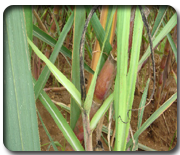 |
Identification of pathogen
Ustilago scitaminea
The fungal mycelium spores are echinulate, light brown and spherical, measuring 6.5 – 8.5 µ in diameter.
-
They germinate readily in water, producing 2-3 celled promycelia.
-
sporidia arise terminally or laterally and they are hyaline, thin walled, single celled and elliptical to linear.
|
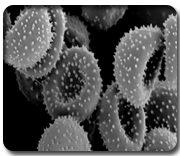 |
Management
Cultural method:
-
Growing of resistant and moderately resistant varieties viz., Co 86249, CoG 93076, CoC 22, CoSi 6 and CoG 5
-
Discourage ratooning of the diseased crops having more than 10 per cent infection
-
Cajanus cajan is grown as a companion crop between rows of sugarcane, the secondary spread of the disease is substantially reduced.
Physical method:
-
Treating the seed setts with Areated Steam Therapy (AST) at 50 ºC for 1 hour or in hot water at 50 ºC for 30 minutes or at 52 ºC for 18 minutes
-
Roguing of smut whips with gunny bags/polythene bag and dipped in boiling water for 1 hour, and diseased clums must be uprooted and burnt
|
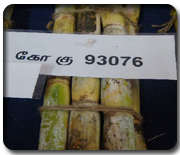 |
Chemical method:
|
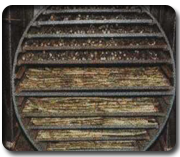 |
Wilt
Symptoms:
External: Gradual yellowing and drying of foliage, shrinkage/withering of canes.
Internal: Light to dark purplish or brown discolouration of ground tissue, pithiness and boat shaped cavities in the middle of the internodes. |
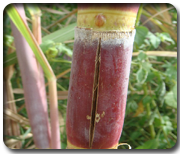 |
Identification of Pathogen
Conidiosphores usually erect and branched. Macroconidia abundant, falcate to rather straight, 3-5-septate, with a distinct foot-cell, 27-73 × 3.4-5.2 mm. Blastoconidia straight or slightly curved, 2-3-septate, fusiform to lanceolate, with a somewhat pointed, often slightly asymmetrical apical cell and a truncate basal cell, 16-43 × 3.0-4.5 mm. |
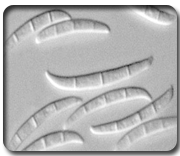 |
Management
Cultural method:
-
Healthy seed, sett treatment with fungicides, resistant varieties, crop rotation, managing root borer, avoiding prolonged drought and water logging and hygienic practices.
|
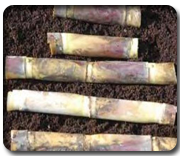 |
Chemical Method:
|
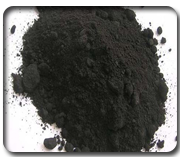 |
Rust
Sugarcane rust is mainly a disease of the leaf. The earliest symptoms are small, elongated yellowish spots that are visible on both leaf surfaces. The spots increase in length, turn brown to orange brown or red brown in color. Pustules, which produce spores, usually develop on the lower leaf surface. |
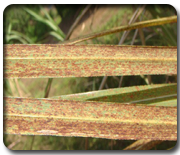 |
Identification of pathogen
Puccinia erianthi
-
Uredinia were elongate, reddish-brown, with capitate, hyaline to light brown paraphyses.
-
Urediniospores were thick-walled, orange-brown, obovoid, measuring 26-34 x 16-20 µm. The urediniospore surface was echinulate with 4-5 equatorial pores.
-
Teliospores were dark brown and measured 30-43 x 17-23 µm, clavate, two-celled and slightly constricted at the septum.
|
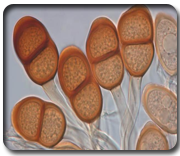 |
Management
Cultural method:
|
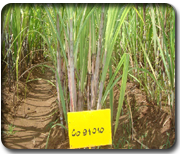 |
Chemical method:
|
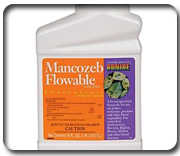 |
Grassy Shoot Disease
Symptoms
Initial symptom appears in the young crop of 3 – 4 months age as thin papery white young leaves at the top of the cane. Later, white or yellow tillers appear in large number below these leaves (profuse tillering). The cane becomes stunted with reduced internodal length. There is no millable cane formation. At times, one or two canes grow well in the affected tillers with greenish leaves. When these seemingly good canes are used for setts, the following crop produces only whitish leaves; these leaves dry early and gaps in the field. |
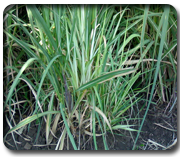 |
Mode of spread
-
The disease is spread by the use of affected setts for planting.
-
Also, the black hopper (Browtista moesta) acts as a carrying agent of this disease.
|
Management
Cultural method:
-
Growing resistant varieties viz., Co 86249, CoG 93076 and CoC 22
-
Avoid ratooning if GSD incidence is more than 15 % in the plant crop
Physical method:
-
Rogue out infected plants in the secondary and commercial seed nursery.
-
Treat setts with aerated steam at 50°C for 1 hour to control primary infection.
-
Treating them with hot air at 540C for 8 hours and spraying twice a month with aphidicides.
|
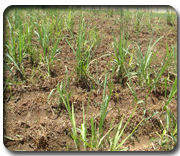 |
Chemical method
|
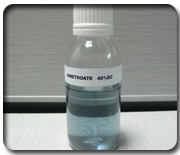 |
Yellow Leaf Disease
Symptom of Damage:
Yellowing of midrib and adjacent laminar region and subsequent leaf drying along the mid rib in 3 to 5 leaves from top. In some cases reddish discolouration is also seen and in severe cases drying of spindle along with leaves. |
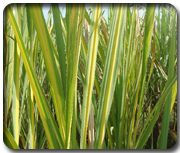 |
Pathogen:
-
The virus is transmitted by aphids, Melanaphis sacchari and Rhopalosiphum maidis, in a semi-persistent manner.
-
SCYLV is a member of the Luteoviridae family. The virus is localized within the phloem cells of the plant.
|
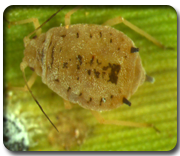 |
Management
Cultural method:
|
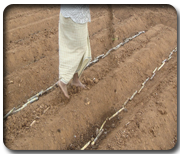 |
Chemical method:
Secondary transmission of the disease by insect vectors can be controlled by application of Malathion(0.1%) or Dimecron(0.2%). |
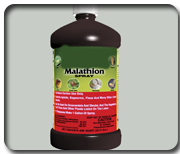 |
Ratoon Stunting
The affected plants are stunted, the stunting being most severe in stubble and ratoon crops. Infected stocks is the presence of pin head like orange coloured dots of bacteria on the internal soft tissue in the nodal region The setts taken from diseased plants germinate poorly and the few shoots that are emerge grow very slowly. It is sap-transmissible and no insect vector has been found. |
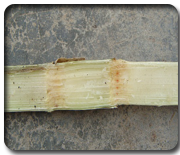 |
Pathogen
The organism that causes RSD is, Leifsonia xyli subsp. xyli, a small aerobic bacterium. The genus ofthe pathogen was previously called Clavibacter. |
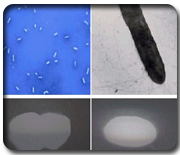 |
Management
Cultural method:
Mechanical method:
Treat setts with hot water at 50°C for about 2 hours give 100 per cent control. |
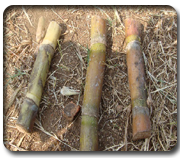 |
|
|













































































